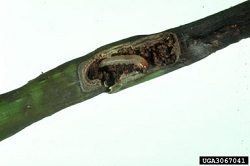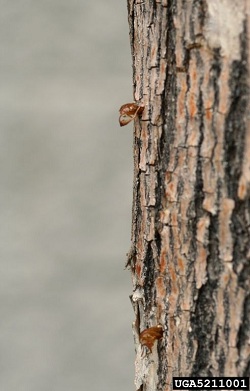Podosesia syringae
Hosts

Photo credit: James Solomon, United States Department of Agriculture Forest Service, Bugwood.org

Photo credit: Whitney Cranshaw, Colorado State University, Bugwood.org
Ash and lilac
Appearance and Life Cycle
The ash borer requires two years to complete its life cycle. The adult is a clearwing moth that resembles a small wasp. Adults are present from late May to late July and deposit clusters of eggs in bark crevices and in wounds caused by pruning or previous borer attacks. After hatching, the larvae bore into the tree and feed on the inner wood for almost two years. In the spring of the third year the full grown larvae make a tunnel almost to the exterior, leaving only a thin covering of bark. The full grown larvae are white with reddish-brown heads and are 18 to 25 millimetres (mm) long. Just before the adult emerges the pupa twists and turns until it breaks the thin layer of bark. As the adult emerges, it leaves behind a pupal skin protruding through the opening.
Damage
The ash borer attacks trees of all ages, but younger, weakened trees are most susceptible. The insect causes damage by making 8 mm diameter tunnels that can extend 100 mm within the wood. Severely-infested trees may contain 50 or more borers that cause weak limbs to break during high winds. Ash borers seldom kill trees directly, but their damage allows other insects and diseases to enter the tree.
Control
Wrap burlap around infested trunks to prevent adult emergence and egg laying. Probe active burrows with flexible wire to kill the larvae. Remove and burn heavily infested trees. The insecticide, chlorpyrifos can be applied to the lower 3 metres (m) of the tree in late May and again in late June for control of the ash borer.